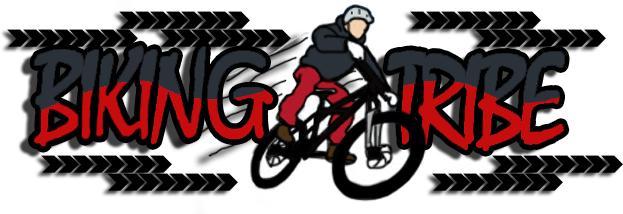- You are here:
- Home »
- Bike Accessories
Category Archives for Reviews
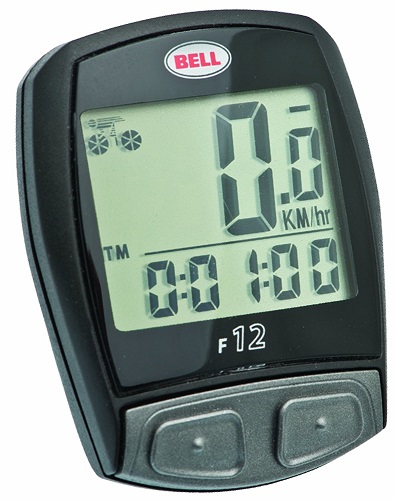
Top 5 Bike Speedometer Reviews
Whether your goal is to improve your fitness or you’re training for a race, a speedometer will be an essential tool. Buying a bicycle speedometer is a great way to track your performance and keep track of your progress when riding. There are plenty of great speedometer options on the market, so it can be tough to narrow down your choices. We’ve put together a list of our top five favorites to help you make your decision a little bit easier.
Our list was based on a few important factors:
Budget
We looked at the cost of each of these speedometers. We’ve attempted to provide a few options in a few different price ranges. We know you don’t want to break the bank when buying a speedometer, but we also know a lot of people in training are willing to spend a little more to get a high quality, accurate bicycle speedometer that gives accurate average speed, maximum speed, and trip distance readings and so on.
Think about how you intend to use your speedometer and how many “bells and whistles” you need. If you simply want to keep track of how fast you are going, you can buy a very affordable, basic speedometer that has a unit on the bike handlebars and a simple speed sensor on the tire. On the other hand, if you’re after a virtual bike computer with the latest LCD screen that also takes into account current speed, heart rate, a GPS system, and a map, for example, you’ll need to pay for an upgrade.
Design
You’ll have a lot of design options when choosing a speedometer. Do you want wireless or wired? Surprisingly, wireless speedometers tend to be less accurate than wired ones. You’ll also need to consider size. Most people want to keep their speedometers fairly small, but you need to make sure it’s large enough you’re able to read the screen while you’re riding. Also, consider whether you want something that can be easily removed from your bike when you are done riding.
Additional Features
Now to the bells and whistles mentioned earlier. If you’re willing to spend a little bit more, you can get a speedometer with a wide variety of features and functions. Basic speedometers simply track distance, speed, and calories burned, but more elaborate ones track heart rate, cadence, temperature, and maximum and average speeds. You’ll get a lot of data you can track and compare – something a lot of riders love having.
You’ll also want a unit that’s weather and rain proof if you intend to do any serious riding. If you’re the type of rider who will only go out when the weather conditions are ideal, there’s no need for this. However, serious riders that are on a training schedule of some kind will need to track their data in all weather conditions.
Other issues to consider is how easy it is to install the speedometer onto your bike. This is especially true for riders who intend to use different bikes or who want to be able to remove the speedometer when it’s not in use.
Finally, consider whether or not you want the speedometer to have the technological capability to sync with your smartphone. Nowadays, riders love to be able to record and track their data in their smartphone because it’s such a convenient option. Not all speedometers offer this feature, but many do. It’s important for you to understand whether or not you want this feature or if it would just be something extra and not worth the extra money.
Comparing Speedometers
At this point, you’ve narrowed down the features you’re looking for in a speedometer and you can begin to compare models. Listed below are five of our favorite models:
Shanren Raptor II

The Raptor II by Shanren is one of the top wireless speedometer options. It is easy to program and operate and provides 17 different functions for users, allow you to track all of your fitness and performance metrics and meet your cycling goals.
It has a backlit LCD display that makes it easy to read in low or bright light. You’re able to see all of your data with just the touch of a button including speed, distance, time, cadence, and calories burned.
CatEye CC-RD300W

This reliable speedometer works every time you ride. It’s a popular option because it’s affordable and offers a quick response. Most users consider it powerful because it’s able to work for any type of riding. It features a large display screen and speed functions and incorporates the highly acclaimed CatEyeClickTec interface, allowing riders to switch through the seven modes with the push of a button. This speedometer also features the innovative FlexTight bracket that makes mounting it easy and fast.
OutdoorMaster JUNSD

The OutdoorMaster is lightweight, durable, and easy to operate. It’s also waterproof so you’re able to ride any time. It can track mileage, speed, and cycling time. This is a wired speedometer, so you know you’re getting accurate damage. Despite it is wiring, it’s still easy and convenient to use, and the small wires really don’t interfere with riding.
It’s easy it is to install and no additional tools are needed. This speedometer also features a 100% satisfaction return policy so you can buy with confidence.
Bell Dashboard

The Bell Dashboard is consistently ranked among the top speedometers on the market. It’s easy to install and weather-resistant. It also features 12 functions that allow riders to efficiently track their speed and distance during the ride. This provides data on current, average, and max speeds.
Ultega Wireless

Riders love the efficiency of the Ultega Wireless All-round device. It’s a powerful multi-functional computer that uses wireless functions and the ability to transmit data on your smartphone or tablet. It features a clear display so you’re able to safely see information registered while riding. It comes with user-selectable of 12- or 24-hour clock, so you can customize your entire experience. It’s also water-resistant, so you’ll be able to schedule your rides in advance and not really worry about weather conditions.
While this isn’t a complete list, it’s a list that should be able to help you narrow down your choices and get a speedometer you love.

Mountain Bike Handlebars Reviews and Recommendations
Getting the best handlebars for your mountain bike (MTB) is essential if you want to get a good ride. They’re a crucial part of controlling your bike and they have a significant impact on how your bike handles—essential when you’re dealing with all terrain surfaces.
Things to consider when shopping for the right MTB handlebars include the seat position, the width, the brake levers and hand position, whether you want backsweep, and the style itself like flat bars, riser bars, and drop handlebars. In most cases, you’ll be able to choose between titanium, aluminum, or carbon. Many pros consider carbon the best of the three because they are so lightweight, but you can get quality handlebars in any of these metals. They all have pros and cons, so you need to decide what’s important to you and go from there.
A few things about handlebar geometry you’ll want to consider:
The rise, which is the height differential between the center of the bar at the stem the center jut after the taper and the transitional bend, are often 0 or flat in MTBs. High rise bars are usually around 40 mm to 50 mm, which is two inches or less. Getting the rise right is usually based on your position when on the bike. Taller riders might feel like the flat rise is too low. Bikes for riding downhill also tend to have a slightly higher rise because it allows for more control. In general, riders just prefer what makes them comfortable, so there’s no right or wrong rise. Try out a few variations and see what makes you most comfortable.
Next, you’ll want to think about sweep. Upsweep is the vertical angle of the bars at the grip and affects the overall rise of the bars. It’s a separate measurement than rise, though. It really doesn’t have an effect on performance, aside from affecting how comfortable you are when riding. Most of the time it’s between four and six degrees.
Backsweep, the other type of sweep, is the angle at which the bars swoop toward the back of the bike. It can range from zero degrees to 45 degrees in specialty bars. Like upsweep, it’s all about comfort and has no bearing on a bike’s performance.
Next up is bar diameter. Mountain bikes are only available in one width at the grip, which is 22.2 mm. However, at the clamp, there are three diameters from which to choose, including 25.4 mm, 31.8 mm, and 35 mm. The clap diameter is the middle where the bar is clamped to the stem and larger clamp areas tend to be stronger and provide an increased surface area with the stem. The main thing you’ll want to know is that if you’re replacing your bars only, you’ll need to be sure what you buy matches your existing stem clamp diameter.
Width of Mountain Bike Bars
Now we’ll talk about the width of handlebars, which is arguably the most important consideration. The common belief is that wider handlebars are better. We tend to agree, at least, when it comes to modern riding and the need for steering control. It also makes your body mechanics better because the wider your arm and chest span with wider bars the easier it is for you to breathe properly when riding.
It’s possible to get handlebars ranging in width from 600 mm to 840 mm. Keep in mind that, despite the belief that wider is better, you still need to go with what makes you feel comfortable and secure. Also, remember it’s always possible to cut down wider bars. If you’re torn, invest in the wider option that you can try out for a while and cut down if necessary in the future.
Metal
Finally, before we get to our recommendations for best MTB handlebars, we’ll take a look at the various metals used to make bars.
Aluminum bars tend to be the cost-conscious option. There are plenty of great aluminum options available, but they are the heaviest, so you’ll need to keep that in mind.
Titanium bars are the most expensive and still have the heaviest weight. They tend to give the harshest ride when it comes to vibration and impact.
Carbon bars, which are quickly becoming the favorite of many, are forgiving and lightweight. Some riders prefer the other options because they believe carbon isn’t as strong, but, in most cases, carbon bars are fine as long as they are made by a reputable manufacturer.
MTB Handlebar Recommendations
Now for our favorites:
LIBRA Sports LHB001C Carbon Fiber Flat Handlebar for Mountain Bike or Road Bike - 31.8 mm Diameter

This is a full carbon bar that’s ultralight at 145 g. It features a 720 mm length and 31.8 mm mounting diameter. We love its unique textured no-slip center section, as well as its UD matte finish with ghost black LIBRA Sports logo. This bar retails for around $50, so it’s a very economical choice.
Crank Brothers Iodine 11

This is also a carbon set of bars, making it super lightweight and flexible. They measure 30.7 inches wide with a 30 mm rise. They also have a nine-degree sweep and five-degree rise. These handlebars are perfect for all-mountain riding and feature a textured area on the stem for zero slippage. Its brilliant, low profile graphics look good and help make the bar a winner. These handlebars retail for around $120.
Spank Spike 777 FR Bearclaw Vibrocore Bicycle Handlebar

These handlebars are lightweight at 310 g and feature a 31.8 mm diameter. They have a shot peen-anodized finish with polish accents and decal logos and feature
Dual XGT, CNC Bending, Impact Ends, and MGR technologies. These handlebars retail between $90 and $100.
Race Face Atlas Riser FR

Another set of aluminum bars, these are 31 inches wide and have a 13 mm rise. There’s an eight-degree sweep and four-degree rise and they retail for around $75.
Renthal Fatbar

These handlebars are available in multiple configurations and come in carbon or aluminum. They consistently rank high among experienced riders. There’s also a light version that is also a couple of inches shorter in width.
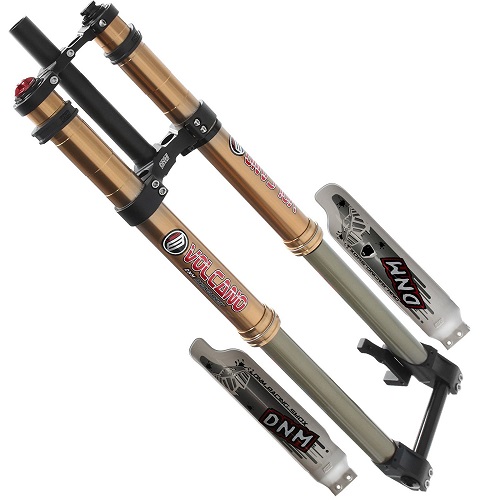
Mountain Bike Forks: Best Options and Reviews 2017
Mountain bike forks are used to help with travel, suspension working as “shocks,” stock, and weight on the bike. You have your choice of dozens and dozens of forks, so you’ll need to think about your specific preferences to narrow down your choices. Your riding style is one of the primary factors in choosing a mountain bike fork.
Mountain bike forks and fork legs are available in a variety of sizes and styles. You’ll also be thinking about how often you ride and what your style of riding is and how much they need to work as shock absorbers. Many of the same considerations you have when choosing the tires, the frame, the rear suspension, the wheel sizes and other components of your bike play a role in choosing a fork. You also have to consider what you are going to use the bike for. Are you looking to create a downhill bike, a cross country bike, or simply an everyday mountain bike?
Once you’ve narrowed down your specific needs, you can begin to comparison shop. We’ve assembled a list of some of the forks we think are the best on the market right now. What’s on our list?
SR Suntour Mountain Bike Disc Fork XCT 26”

This fork does offer travel adjustment of 80 mm or 100 mm. It fits a 9 mm axle, but only works with disc brakes. It has aluminum lower legs. This is an “entry level” fork and is not sufficient for downhill riding or extreme rides—it’ll perform best on simple trails and easier riding paths for beginner riders or those who are just not going hard at the time. It weighs about five pounds—so it’s a bit on the heavy side—and has a standard 1 1/8 inches steerer tube attached. This is one of the more affordable forks on the list, making it ideal for beginners. This fork retails for around $70.
Nashbar Rigid 26” Mountain Bike Fork
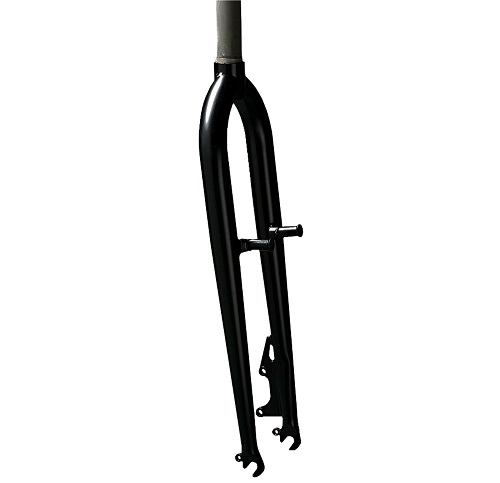
This is another affordable fork that offers solid quality for not that much money. This is one of the simplest forks on the list and it’s rigid and able to be customized. You’ll get extra clearance to keep out of mud and debris, but it’s not going to affect the handling of your bike. It features a 1 1/8” diameter steerer tube and is compatible with disc or rim brakes, as long as your wheels are small enough. Larger wheels need to use disc brakes—otherwise you won’t be able to clear the fork. This fork isn’t cut out for extreme riding but is a great option for beginning or intermediate riders. This fork retails for around $45.
RockShox 30 Gold TK Crown Adjust Solo 100 mm Air Fork

This 100 mm travel fork is very light (it weighs less than four pounds) and uses air to create a light feel as you ride. You’ll enjoy a smooth ride—even on extreme rides—with increased performance with this fork. We love this fork for its ability to absorb all of the bumps you’ll hit along the trail. It features a turnkey lock out. One of the downsides of this fork is its installation. It can be tough if you don’t have the tools you need and if you’re not experienced with installing forks. The travel on this fork cannot be changed. For a higher than average price, though, we think this is a great, high-quality option. This fork retails for around $300.
RockShox 30 Silver TK Fork: 27.5", 100 mm, Coil, 9mm QR, Crown Adjustment, 1-1/8" Alum Steerer, Disc Brake, A3, Gloss

This is a suspension fork that works with both disk and rim brakes. It features aluminum lower legs and weighs approximately seven pounds. It has a travel of 100 mm and is compatible with 9 mm front hubs. Its turnkey lock will last at least a year and is specifically designed to be long-lasting. This fork is also able to be modified to suit your specific needs, but keep in mind that you can’t adjust the travel on it. This model features a four piece bushing system.
You’ll get a long-lasting fork that provides smooth suspension for an affordable price. However, the added weight can throw off hardtail suspension bike and the weight exceeds competition limits. This fork retails for around $170.
DNM USD-8 Downhill Mountain Bike Air Fork
This fork is the one you need if you’re into extreme riding and love downhill on rough terrain. The DNM USD-8 is high quality, but you’ll pay for it. It features a long travel of 203 mm and is able to utilize a three-system damping and bottom out. It is truly the ideal fork for riders who love rough terrain, or who are looking for a race fork. It absorbs all impact and you’ll barely even notice bumps when you’re riding.

This fork is 29.6 inches long and weighs eight pounds, so it’s not lightweight by any means. It also only works with disc brakes. There are three adjustments possible, which include preload, rebound, and adjust high pressure. Despite the high performance of this fork, it’s not made for pro cycling. It’s also expensive, so it’s not going to be the first choice for many riders, especially beginners or novice riders. But if you’re looking for the highest quality fork that isn’t pro-approved, this is it. This fork retails for around $400.
ZOOM 565 Suspension Fork for Mountain Bike AL 80 mm Travel 1-1/8" QR Disc Brake(IS) and V-Brake

This fork is fit for 26-inch disc brakes or for a V-Brake Mountain Bike. It has a 15-inch travel length and weighs just under five pounds. It provides a powerful, functional riding experience and is a great option at a reasonable price. It retails for around $85.
XOSS MTB Front Suspension Forks, Replacement Bike Air Shock Aluminium Alloy Fork 26/27.5 100 mm Travel

This aluminum alloy fork is durable and lighter than many other fork options. It’s fit for 26''/27.5'' bike. It comes in two colors (black or white) and features an airspring, 100 mm travel, and adjustable travel valve. Its diameter steerer tube is 28.6 mm. It retails for around $135.
These are a few of the best forks available for mountain bikes. Take some time to think about what you need and how much you want to budget. You’re sure to be able to find exactly what you need for a price you find affordable.
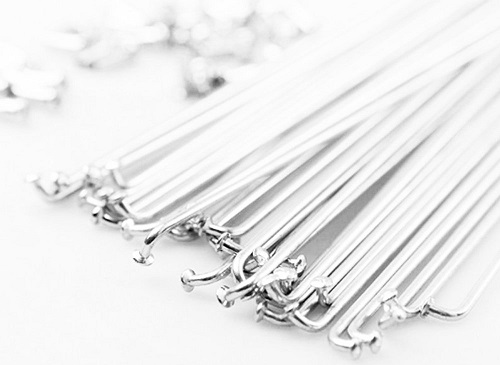
Bike Spokes That Will Last: Reviews 2017
Spokes are one of three important parts of a bicycle’s wheel. Like the other two parts—the hub flanges and the wheel rims—if the spokes are not working properly or are of poor quality, it will affect the performance of the tire and of the entire bike. Spokes are responsible for holding the tire system together and allow the wheels to have strength.
There are three different types of bicycle spokes: the plain gauge spoke, the aero spoke, and the butted spoke. Plain gauge spokes are basic spokes that are used about 90 percent of the time for riders.
Bicycle spokes need to be able to withstand both constant and inconstant force. Some of the force is absorbed by other components of the bike, but spokes still need to stand up to impact. Different types of spokes stand up to force in different ways and all have their pros and cons. What should you know about the different kinds of spokes?
Butted Spokes
Butted spokes are some of the most common in use and within this category are a few different options. Laser spokes, made from a different type of stainless steel is a high-tension spoke. It makes bike wheels strong and stable. These heavy-duty spokes are right for most applications but are not recommended for high transmission riding.
D-Light bicycle spokes combine the benefits of racing spokes with laser spokes and it’s compatible with all of the same hubs and nipples. The final option is a super spoke that is made of stainless steel (so it’s strong), but it’s lighter than other types of stainless steel spokes. These spokes are produced by a specific company with a secret formula for the metal blend and they are very expensive and available only via special order.
Aero Spokes
Aero spokes are made from butted spokes, so you get the benefits of those spokes, but they also offer a variety of aerodynamic benefits. This improves the strength of the spokes and increases their lifespan. There’s also less spoke twist.
Keep in mind, the strength measurement of a spoke is not the overall strength, but a comparison of the strength of its central portion. The central portions on some spokes are slimmer which makes them look strong and offer greater strength than laser spokes despite looking weaker to the naked eye.
Considerations When Choosing Spokes
There are several things you need to consider when shopping for spokes, in addition to the basic type of spoke you want to buy.
First and foremost, it’s important to understand the differences in wheels. Front wheels carry less stress than rear wheels, so you need to make your decisions based on that knowledge. Front wheels don’t need spokes as strong as back wheels, which means if you want to enjoy the benefits of weaker spokes, you can do so by putting them on the front tire. You can also use fewer spokes on front tires.
Front bicycle wheels can usually be both radially or tangentially laced, so the spokes can either come directly out of the hub to the rim or at tangents to the hub. It can be tough to find exactly what you need if you prefer specialized builds, so you’ll need to shop around and look for a manufacturer that makes the spokes you want.
Also, keep in mind that re-lacing your spokes in a manner not conducive to what the manufacturer recommends because it can void warranties on the tires. Many experts recommend not using radial lacing because it causes distortion in the hubs and creates a weaker wheel and rougher ride. It’s also a stiffer lacing pattern, which is why radial lacing is done on the front wheels so often. If radial lacing is your preferred method, you can lace heads in or heads out, the former of which creates a stiffer lace and puts more strain on the spoke. If you have any doubts, your local bike shop will be happy to re-lace your spokes for you to ensure the perfect tension and an accurate lacing.
Despite advice against doing so, some people prefer radial lacing for aesthetic purposes. There are also some functional reasons you might want to lace your spokes in such a manner.
Choosing the Best Bike Spokes that Last
Now that you know a little about the different types of spokes and how they can be used differently on a bike tire, here are a few options for what we think are the best spokes available:
36pcs Steel Spokes Mountain Bike Spokes

These MTB 251 mm–268 mm W/nipples retail for around $10 for 36 spokes. They are made from #45 steel and have a diameter of 2 mm. These spokes are reasonably priced and strong enough to stand up to basic riding.
Standard J Bend Bike Spokes and Nipples

These UCP steel spokes come in silver and retail for around $7 to $12, depending on what size you need. You get a pack of 12 spokes and 12 nipples, which makes them a pretty good value for the quality spoke you’re getting.
36pcs Stainless Steel Spokes Mountain Bike Spokes MTB 258 mm–269 mm W/Nipples

These spokes are made from stainless steel and measure 2 mm in diameter. They come in a package of 36 nipples, 36 spokes and retail for about $15. The spokes come with a rust-free guarantee, so you can return them for your money back if they rust.
These are just a few spoke options available. You can get spokes in a variety of price ranges and a variety of sizes. Your best bet if you are serious about using spokes to change your riding performance is to try out a few different varieties and lacings. This way you’ll get a feel for what you like. There are many options that offer functionality and durability, so much of the decision comes down to personal preference.
On the other hand, if you just need to replace older spokes or you want something basic to work with, you can choose any of the spokes listed above. They are all durable and affordable, so you can’t go wrong with the standard choices available.
